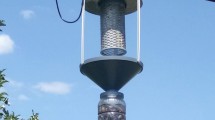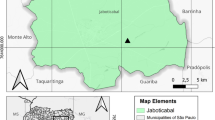Abstract
The damage resulting from oak wilt disease, caused by a pathogenic fungus transmitted by the ambrosia beetle Platypus quercivorus Murayama (Coleoptera: Platypodidae), was comparatively assessed using oak log pile traps. Oak wilt disease has caused extensive damage to native oak species and forests in Japan. The ambrosia beetle P. quercivorus has been legally declared a pest by the Forest Pest Control Act. In forests infested by the ambrosia beetle, development of effective control methods to reduce or eliminate the damage is needed. Field investigations were conducted to confirm the effectiveness of oak log pile traps on the control of oak wilt disease. As a result, the number of trees exhibiting defoliation caused by oak wilt disease was significantly different between an area with the oak log pile traps and a trap-free area. Thus, oak log pile traps have possibilities for reducing oak wilt disease as well as controlling disease damage in spatial spread areas.



Similar content being viewed by others
References
Esaki K (2008) Control effects of the oak borer Platypus quercivorus (Coleoptera: Platypodidae) by spraying trunk surface with fenitorothion. J Jpn For Soc 90:391–396 (in Japanese with English summary)
Forest Agency (2012) Annual report on forest and forestry in Japan fiscal year 2011. http://www.rinya.maff.go.jp/j/kikaku/hakusyo/22hakusho/pdf/22_e.pdf. Accessed on 15 May 2015. (in Japanese)
Ito S, Kubono T, Sahashi N, Yamada T (1998) Associated fungi with the mass mortality of oak trees. J Jpn For Soc 80:170–175 (in Japanese with English summary)
Japan Forestry Investigation Committee (2003) Standing tree volume table -Eastern Japan- (Forest Agency Ed.). p. 333 (in Japanese)
Kinuura H (2002) Relative dominance of the mold fungus, Raffaelea sp., in the mycangium and proventriculus in relation to adult stages of the oak platypodid beetle, Platypus quercivorus (Coleoptera; Platypodidae). J For Res 7:7–12 (in Japanese with English summary)
Kobayashi M, Hagita M (2003) Protection method of Platypus quercivorus (Murayama) (Coleoptera; Platypodidae) by covering trunk water proof sheet. Forest Pests 52:137–147 (in Japanese)
Kobayashi M, Ueda A (2003) Observation of mass attack and artificial reproduction Platypus quercivorus (Murayama) (Coleoptera; Platypodidae). Jpn J Appl Entomol Zool 47:53–60 (in Japanese with English summary)
Kondoh H, Yamanaka T, Saito S, Shoda-Kagaya E, Makino S (2015) Development of a hazard map for oak wilt disease in Japan. Agri For Entomol 17:205–213
Kubono T, Ito S (2002) Raffaelea quercivora sp. nov. associated with mass mortality of Japanese oak, and the ambrosia beetle (Platypus quercivorus). Mycoscience 43:255–260 (in Japanese with English summary)
Madrid F, Vite P, Renwick JAA (1972) Evidence of aggregation pheromones in the ambrosia beetle Platypus flavicornis. J Appl Entomol 72:73–79 (in Japanese with English summary)
Masuda N (2005) Protection method by liquid bond to Platypus quercivorus (Coleoptera: Platypodidae). Abstr Ann Meet Kansai Chapter’s Forest Soc 56:65 (in Japanese)
Milligan RH (1982) Evidence for an aggregating pheromone in Platypus apicalis. In: Insect pheromones and their application. Entomology Division Report 2. Galbreath RA (ed) New Zealand Department of Scientific and Industrial Research, pp 37–50 (in Japanese with English summary)
Milligan RH, Ytsma G (1988) Pheromone dissemination by male Platypus apicalis White and P. gracilis Broun. J Appl Entomol 106:113–118 (in Japanese with English summary)
Nogami M, Ohba H (1991) Vegetation in Japan by the warmth index. Jpn Sci 61:36–49 (in Japanese)
Ohashi A (2007) Protection of the mass mortality of oak trees by bond. Abstracts of the 118th Annual Meeting of the Japanese Forest Society: PB076 CD-ROM (in Japanese)
Okada M (2010) Protection test by chemical to Platypus quercivorus (Coleoptera: Platypodidae). Report For Chem 2010:127–129 (in Japanese)
Saito S (2005) Protection method of oak mass mortality by insecticide and bond (Results of research selection of Forest’s public research organization 2) Forestry and Forest Products Research Institute’s Editor, pp 19–20 (in Japanese)
Saito S (2008) Current understanding of the mass mortality of oak trees and what we should do from now. Tohoku J Forest Sci 13(1):16–20 (in Japanese)
Saito S (2013) Prevented mass mortality of oak trees by the trinity “control, wood utilization and regeneration of forest”. JATAFF J 1(5):29–33 (in Japanese)
Saito S and Nozaki A (2008) Command of oak mass mortality and promoting method of protection. (Forestry spread library 157 oak mass mortality and health of countryside forest, Keiko Kuroda’s editor, Association of forestry spread). 109–134 (in Japanese)
Saito S, Shibata M (2012) The forest structure and tree death rate of forest stands damaged by Japanese oak wilt in Yamagata Prefecture. J Forest Soc 94:223–228 (in Japanese with English summary)
Saito S, Nakamura H, Miura N, Onose K (1999) The control method of oak mass mortality by chemicals. For Pests 48:84–94 (in Japanese)
Saito S, Nakamura H, Miura N, Onose K (2000) Refinement of control method of oak mass mortality by injecting NCS into oak trees. For Chem 152:18–24 (in Japanese)
Saito S, Nakamura H, Miura N (2003) Challenge of new protection method on oak mass mortality by insecticide and bond. For Chem 166:18–24
Saito S, Ichihara Y, Kinuura H, Ino M (2008) Effective attraction of synthetic pheromone to Platypus quercivorus (Coleoptera: Platypodidae) combining with co-attractants. Tohoku J Forest Sci 13(2):1–4 (in Japanese)
Saito S, Nakamura H, Okada M, Honma K (2014a) Preventive effect of trunk injection of benomyl wettable powder on mass mortality of oak trees. Jap J Pesticide Sci 39:10–17 (in Japanese with English summary)
Saito S, Okada M, Miguchi H (2014b) The control of mass mortality of oak trees by accumulated mass logs. Forest Pests 63(6):25–31 (in Japanese)
Saito S, Okada M, Tsuruta H, Ino M (2014c) Prevention of oak wilt trees by trunk injection of high concentration triforine emulsion. Tohoku J Forest Sci 19(1):12–17 (in Japanese)
Saito S, Miguchi H, Shoda-Kagaya E (2015) Attracting effect of mass accumulated oak logs for Platypus quercivorus. J Forest Soc 97(2):100–106 (in Japanese with English summary)
Shimizu Y (2014) Process of the formation of Japanese forest and typification of vegetation zone –From an East Asian viewpoint. Regional views 27:19–75 (in Japanese with English summary)
Sone K, Uto K, Fukuyama S, Nagano T (2000) Effect of attack time on the development and reproduction of the oak borer, Platypus quercivorus (Murayama). Jpn J Appl Entomol Zool 44:189–196 (in Japanese with English summary)
Tokoro M, Kobayashi M, Saito S, Kinuura H, Nakashima T, Shoda-Kagaya E, Kashiwagi T, Terabayashi S, Kim C-S, Mori K (2007) Novel aggregation pheromone, (1S, 4R)-p-menth-2-en-1-ol, of the ambrosia beetle, Platypus quercivorus (Coleoptera: Platypodidae). Bull FFPRI 6:49–57 (in Japanese with English summary)
Ueda A, Kobayashi M (2005) Attraction of Platypus quercivorus (Murayama) (Coleoptera: Platypodidae) to logs bored by conspecific silent males. Bull FFPRI 4:39–44 (in Japanese with English summary)
Yamagata Prefecture Forestry Research and Training Center (2012) Transition of oak wilt disease damage until 2010. https://www.pref.yamagata.jp/ou/norinsuisan/142003/h22seikacard/h22narakosonhigai2010.pdf. Accessed on 12 October 2015 (in Japanese)
Acknowledgments
This study was supported by a research grant from the Agriculture, Forestry and Fisheries Research Council (Project No. 2022), and by a Grant-in-Aid for a Research Project Utilizing Advanced Technologies in Agriculture, Forestry and Fisheries (Project No. 24030) from the Ministry of Agriculture, Forestry and Fisheries, Japan. We thank T. Futaba, T. Watanabe, and H. Ebihara from the Oguni Town Office, Y. Saraya from the Oguni Town Forest Owner’s Cooperative, H. Koseki and K. Shisai from the Yamagata Prefectural Office, and officers of the Okitama Forest for their assistance during the research on the forest stands.
Author information
Authors and Affiliations
Corresponding author
Rights and permissions
About this article
Cite this article
Saito, S., Kondoh, H., Takahashi, A. et al. Reducing damage caused by oak wilt disease transmitted by the ambrosia beetle Platypus quercivorus (Coleoptera: Platypodidae) using oak log pile traps. Appl Entomol Zool 51, 267–274 (2016). https://doi.org/10.1007/s13355-016-0398-3
Received:
Accepted:
Published:
Issue Date:
DOI: https://doi.org/10.1007/s13355-016-0398-3




